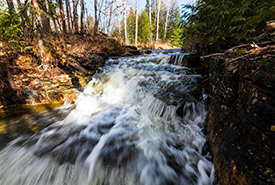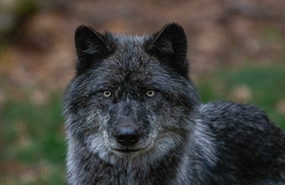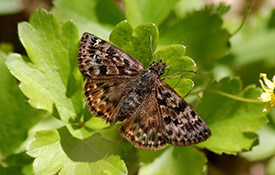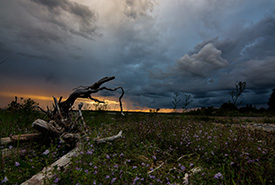Vidal Bay Forests and Shoreline

Waterfall, Vidal Bay, ON (Photo by Esme Batten/NCC staff)
Ontario’s largest protected area complex south of the Canadian Shield
Located in Lake Huron, the internationally significant Manitoulin Island is the largest freshwater island in the world. It supports some of the highest quality alvar habitat on the planet, interspersed within sand plain forests, wetlands, sand dunes, shoreline and the Niagara Escarpment. At the northern edge of southern Ontario, Manitoulin is home to wide ranging mammals, including black bear and gray wolf, and provides an important stopover area for migratory birds.
Quick facts
- Location: Manitoulin Island
- Habitat type: shoreline, forest and provincially significant alvars
- Size: 7,608 hectares (18,800 acres) including 18.5 kilometres of shoreline on the north channel of Lake Huron
- Total project cost: Approximately $16,000,000
- Carbon stored by property: 8,764,969 tonnes of CO2 equivalent (CO2e)
- Annual carbon sequestration: 22,675 tonnes of CO2e per year; equivalent to the carbon emissions from the electricity used by 4,119 homes each year
- Species: American black bear, gray wolf, mottled duskywing, Lakeside daisy, Hill’s thistle, eastern wood-pewee, Blanding’s turtle, least bittern, otter
Protected for the long-term
With the generous support of partners, public and private donors, and the local community, NCC has acquired 7,608 hectares (18,800 acres) on Manitoulin Island at Vidal Bay. When combined with nearby and adjacent conservation lands that we have already conserved, this makes up a protected area complex of 250 square kilometres (24,860 hectares/61,435 acres), the largest of its kind south of the Canadian shield in Ontario. In total, it conserves an astonishing 86 kilometres of Great Lakes shoreline, more than twice what is currently protected at Bruce Peninsula National Park. This project has helped set a new standard of large landscape-scale conservation in Ontario.
The Vidal Bay Forests and Shoreline property features coastal cliffs, undeveloped Lake Huron shoreline, inland lakes and wetlands, intact forests and alvars. According to the International Alvar Conservation Initiative, the alvars of western Manitoulin Island are the best remaining examples of this type of globally rare habitat in North America, where the limestone pavements and thin soils set the stage for a unique assemblage of rare and endemic plant species.
Protecting large swaths of high-quality habitat is essential for the ongoing survival of the millions of migratory birds that pass through southern Ontario every spring and fall. The Vidal Bay Forests and Shoreline property supports a wide range of birds, including warblers, vireos and scarlet tanagers. The wetlands and shoreline are important habitat for breeding and migrating waterfowl, including ducks, loons and grebes. With its protection, we will be able to continue to enjoy these birds into the future.
A region under pressure

Wolf (Photo by Mhairi McFarlane/NCC staff)
Manitoulin Island is and always has been a priority for conservation for its undeveloped Great Lakes shorelines, globally rare alvars and meadow marshes. The island is home to globally rare and at-risk plants, such as Lakeside daisy and Hill’s thistle, as well as the endangered mottled duskywing butterfly. It plays host to at-risk birds and reptiles, and supports healthy populations of white-tailed deer, black bear and gray wolf.
But the island faces many challenges. Each year, the quiet beaches, soaring cliffs and clear turquoise water bring more people to visit Manitoulin Island. Ever growing development pressures for cottages and second homes pose a significant threat and, like most Great Lake shorelines, the opportunities for conservation have become few and far between.
Conservation to combat climate change

Male mottled duskywing (photo by Jessica Linton)
The property’s alvars, forests, wetlands and grasslands provide essential ecosystem services to the region. This includes carbon storage, removal of air pollution and flood water storage. While the carbon sequestration and storage benefits of the property are important in our collective efforts to reduce green-house gas levels in the atmosphere, this property is particularly critical for water quality and quantity and the protection of intact shoreline. The property provides an excellent example of the scale we need to work at in order to combat climate change.
Mnidoo Mnising – The heart and spirit of the Great Lakes

Queen Elizabeth The Queen Mother Mnidoo Mnissing Provincial Park, ON (Photo by Esme Batten/NCC staff)
This property is located directly north of and adjacent to the 6,530 hectare (16,135 acre) Queen Elizabeth The Queen Mother Mnidoo Mnissing Provincial Park, a property NCC and our partners were instrumental in conserving in the late 1990s. Just to the west is NCC’s Cockburn Island Conservation Lands, nearly 10,730 hectares (26,500 acres). By securing Vidal Bay Forests and Shoreline, we will create a total protected complex of over 24,860 hectares (61,435 acres). This project will set a new standard for large, landscape-scale conservation in southern Ontario. It will redefine the vision of wildlife corridors in the province, creating a shore to shore, continuous stretch of wilderness in an area where projects of this magnitude are rare.
Mnidoo Mnising in the Anishnaabeg language means the Heart and Spirit of the Great Lakes. By protecting the Vidal Bay Forests and Shoreline property, we will be helping to further protect the heart of Manitoulin Island. Indeed, this project is truly vital to Great Lakes conservation.
Manitoulin Island is the traditional territory of the M’Chigeeng First Nation, Aundeck Omni Kaning First Nation, Sheguiandah First Nation, Sheshegwaning First Nation, Whitefish River First Nation, Wiikwemkoong Unceded Territory and Zhiibaahaasing First Nation. With gratitude and respect, we acknowledge the significant, ongoing role of Indigenous Peoples on these lands. We look forward to engaging with these communities in discussions about ways that these natural lands can continue to support the people with whom they are intertwined.
Manitoulin Island Archipelago: A priority for conservation
Please consider a gift to help protect and care for the Manitoulin Island Archipelago Natural Area.
For more information or to discuss your donation options, please contact:
Pia Kaukoranta Vahabi
Acting Director of Development & Communications
pia.vahabi@natureconservancy.ca
416.220.3784





